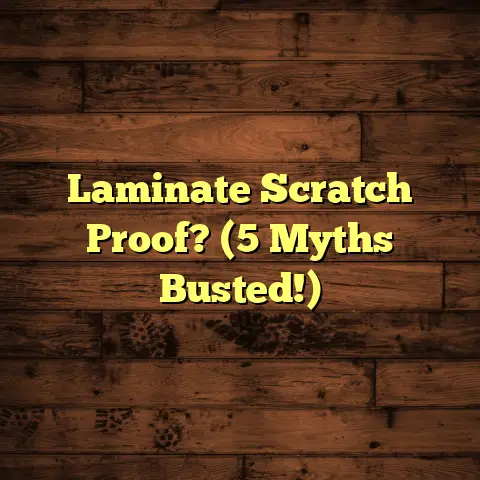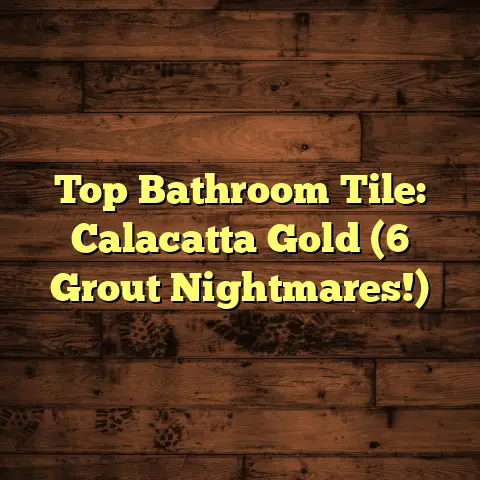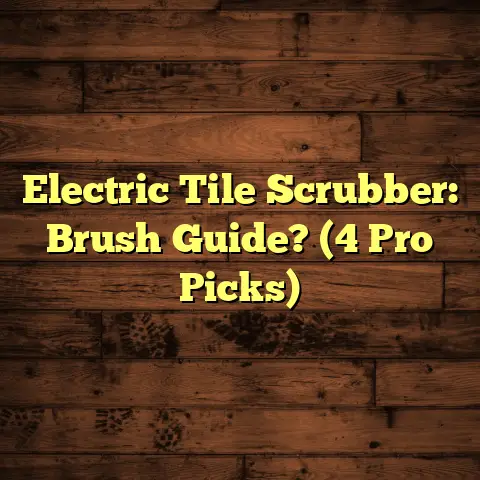Laminate Spill? (5 Min Fix, Prevent Swelling!)
I know that feeling. The rich aroma of coffee, suddenly tainted by the chill of panic. Been there, cleaned that!
And believe me, I’ve seen it all in my years as a flooring contractor. Today, I’m going to share my secrets to tackling those spills fast.
More importantly, I’ll show you how to prevent that dreaded swelling that can ruin your beautiful laminate. Let’s get to it!
Section 1: Understanding Laminate Flooring
First, let’s talk about what laminate actually is. It’s not solid wood, and that’s important to know.
What is Laminate Flooring?
Think of laminate as a carefully crafted sandwich. It’s made of multiple layers, each with a purpose:
-
Wear Layer: This is the top dog. It’s a clear, protective layer that resists scratches, dents, and fading. The thicker, the better!
-
Design Layer: This is where the magic happens. A high-resolution image of wood, stone, or tile is printed on this layer, giving laminate its realistic look.
-
Core Layer: The heart of the laminate. Typically made of high-density fiberboard (HDF) or medium- density fiberboard (MDF), this layer provides stability and impact resistance.
-
Backing Layer: The foundation. This bottom layer provides a moisture barrier and helps to balance the plank, preventing warping.
So, why choose laminate? Well, there are a bunch of reasons it’s a popular choice:
-
Durability: That wear layer is tough! Laminate can withstand a lot of foot traffic and everyday wear and tear.
-
Cost-Effectiveness: Compared to hardwood or tile, laminate is much easier on the wallet. You get the look without breaking the bank.
-
Aesthetic Versatility: Seriously, you can find laminate that looks like anything. Wood, stone, tile – you name it. There’s a style for every taste.
Common Characteristics of Laminate Flooring
Now, here’s the thing: laminate is water-resistant, not waterproof. There’s a big difference!
Water-resistant means it can handle small spills if you clean them up quickly. Waterproof means it can withstand prolonged exposure to water.
Laminate’s core is wood-based, and wood hates water. When water seeps into the seams or edges, it can cause the core to swell, leading to warping and damage.
That’s why proper installation is key. A tight, secure installation minimizes the risk of water getting in.
And regular maintenance? Absolutely crucial. Keeping your laminate clean and dry will extend its lifespan and keep it looking its best.
Section 2: The Nature of Spills and Their Impact on Laminate
Okay, let’s talk about the enemy: spills. They’re inevitable, but understanding how they affect laminate is the first step to protecting your floors.
How Spills Can Affect Laminate Flooring
-
Immediate Effects: The most obvious is surface damage. Stains from coffee, wine, or juice can penetrate the wear layer, especially if left untreated. And nobody wants that!
-
Long-Term Effects: This is where things get serious. If liquid seeps into the seams, it can cause the core to swell. This leads to warping, buckling, and even mold growth. Yikes!
Types of Liquids That Are Most Damaging to Laminate
Not all spills are created equal. Some liquids are more harmful than others. Here’s the breakdown:
-
Water: The biggest culprit. Even clean water can cause damage if left to sit for too long.
-
Oils: These can leave greasy stains that are tough to remove. Plus, they can attract dirt and grime.
-
Acidic Substances: Vinegar, lemon juice, and some cleaning products can etch or discolor the wear layer.
And when comparing solid vs. liquid spills, liquids are the bigger threat. Solids can usually be swept or vacuumed up easily, but liquids can seep into the seams and cause hidden damage.
Section 3: The 5-Minute Fix for Laminate Spills
Alright, time for action! Here’s my step-by-step guide to tackling spills immediately and preventing long-term damage.
Step-by-Step Guide to Addressing Spills Immediately
-
Assess the Situation: First, take a deep breath and assess the damage. How big is the spill? What kind of liquid is it? The faster you act, the better.
-
Gather Necessary Tools: You’ll need a few essentials:
-
Absorbent Cloths: Microfiber cloths are my go-to. They’re super absorbent and won’t scratch the surface.
-
Mop: A microfiber mop is perfect for larger spills.
-
Mild Cleaning Solution: A mixture of water and dish soap works wonders. Avoid harsh chemicals or abrasive cleaners.
-
-
Cleaning the Spill:
-
Blot, Don’t Rub: Gently blot the spill with an absorbent cloth. Rubbing can spread the liquid and grind dirt into the surface.
-
Mop It Up: For larger spills, use a damp mop to clean the area. Be sure to wring out the mop thoroughly.
-
Stubborn Stains: For tough stains, apply a small amount of mild cleaning solution to a cloth and gently rub the stain.
-
-
Drying the Area: This is crucial! Use a clean, dry cloth to thoroughly dry the area. You can also use a fan to speed up the drying process. Make sure there is no moisture left on the surface.
Real-Life Scenarios and Quick Fixes (Case Studies)
-
Coffee Spill: I had a client who spilled coffee all over their laminate floor. They panicked and started scrubbing, which only made things worse. I advised them to blot the spill immediately, then use a damp mop with a mild cleaning solution. They were amazed at how quickly the stain disappeared!
-
Juice Spill: Juice spills can be sticky and attract dirt. The key is to clean them up quickly and thoroughly. Use a damp cloth with a mild cleaning solution, then dry the area completely.
-
Pet Accidents: Pet accidents are a fact of life, especially if you have furry friends. The key is to clean them up immediately to prevent stains and odors. Use an enzymatic cleaner specifically designed for pet accidents.
-
Testimonial: “I spilled red wine on my laminate floor and thought it was ruined,” says Sarah M., a homeowner. “But I followed your advice and blotted the spill immediately, then used a damp mop with a mild cleaning solution. The stain came right out! I was so relieved.”
Section 4: Preventing Swelling and Long-Term Damage
Okay, you’ve mastered the 5-minute fix. Now, let’s talk about prevention. Because let’s face it, avoiding spills in the first place is the best strategy.
Prevention Strategies for Laminate Flooring
-
Regular Maintenance Tips:
-
Cleaning Routine: Sweep or vacuum your laminate floor regularly to remove dirt and debris.
-
Protective Measures: Use mats at entrances to trap dirt and moisture. Place felt pads under furniture legs to prevent scratches.
-
-
Importance of Moisture Barriers and Proper Installation:
-
Moisture Barriers: A moisture barrier underlayment is essential for protecting your laminate floor from moisture from below.
-
Proper Installation: Hire a professional installer to ensure a tight, secure installation. This will minimize the risk of water seeping into the seams.
-
How to Handle Potential Future Spills
-
Creating a Spill Response Kit:
-
Absorbent Cloths: Keep a stash of microfiber cloths handy.
-
Mild Cleaning Solution: Mix water and dish soap in a spray bottle.
-
Enzymatic Cleaner: For pet accidents.
-
Fan: To speed up the drying process.
-
-
Educating Family Members About Spill Management:
-
Spill Drills: Okay, maybe not drills, but make sure everyone knows the importance of cleaning up spills immediately.
-
Designated Clean-Up Crew: Assign spill clean-up duties to different family members.
-
Section 5: The Role of Homeowner Awareness and Education
Let’s get real: laminate is great, but it’s not indestructible. Understanding its limitations is key to keeping it looking its best.
Understanding the Limitations of Laminate Flooring
-
Myths vs. Realities of Laminate Durability:
-
Myth: Laminate is waterproof. Reality: Laminate is water-resistant, not waterproof.
-
Myth: Laminate is scratch-proof. Reality: Laminate is scratch-resistant, but it can still be scratched by sharp objects.
-
-
Importance of Knowing Your Flooring’s Specifications:
-
Read the Fine Print: Check the manufacturer’s recommendations for cleaning and maintenance.
-
Know Your Wear Layer: The thicker the wear layer, the more durable your laminate will be.
-
Community Resources and Support
-
Online Forums: There are tons of online forums where you can ask questions and get advice from other homeowners.
-
Local Workshops: Check your local home improvement stores for workshops on flooring maintenance.
-
Professional Services: When to Call in the Experts:
-
Severe Damage: If you have significant swelling, warping, or mold growth, it’s time to call in a professional flooring contractor.
-
DIY Disasters: If you’ve tried everything and nothing seems to be working, don’t hesitate to seek professional help.
-
Conclusion: Embracing Laminate Flooring with Confidence
So, there you have it! With a little knowledge and some quick action, you can keep your laminate floor looking beautiful for years to come.
Remember, quick action and prevention are key. Don’t let spills ruin your day. Embrace the beauty and practicality of laminate, equipped with the knowledge and preparedness to handle anything life throws your way.
Now go forth and enjoy your beautiful, spill-free laminate floor! You got this!





